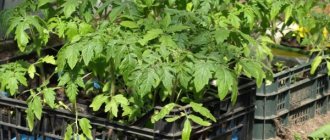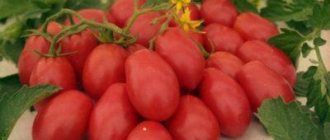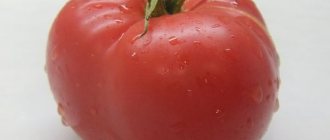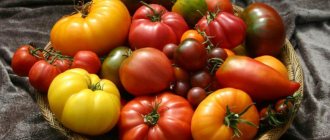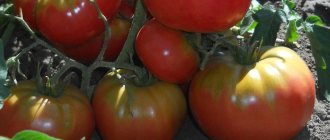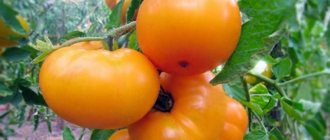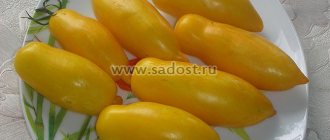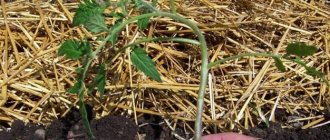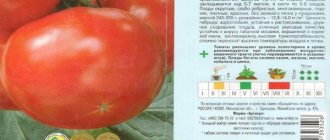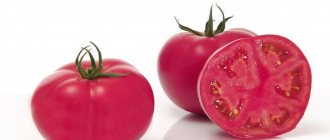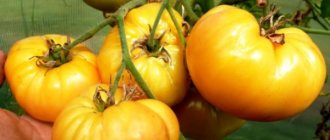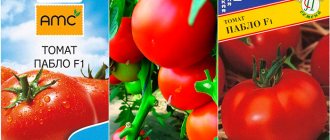Characteristics and description of the variety
Tomatoes Banana legs are medium-sized and belong to the semi-determinate type. The height of the bush does not exceed 70-80 cm in open ground and 1-1.5 m in a greenhouse.
The leaves and stems of the variety are thin, so you can plant two tomato bushes in one hole.
After 9-11 leaves, the first inflorescence is formed on the stem. The next ones are laid every 2-3 sheets.
The first harvest at the stage of technical ripeness can be harvested 90-95 days after emergence.
When fruits are fully biologically ripe, they acquire a bright orange color with yellow stripes and barely noticeable splashes of pink.
The skin of the Banana Legs variety is dense, so the tomatoes are not prone to cracking.
The fruits have an elongated shape with a tuberculate surface and a pointed nose pulled to the side. The average weight of one tomato is 80 g.
The pulp has two seed chambers with a small number of seeds. When not fully ripened, the photo shows that the inside of the tomato has a central white vein.
The State Register commission noted the taste of the tomato as good. But, like most early varieties, Banana Legs does not have a pronounced tomato aroma. The taste has a characteristic sourness, the flesh is quite dense.
Tomatoes are ideal for pickling for the winter and for making fresh salads.
The variety's seeds are produced for sale by the agricultural company Partner.
Video
You can also watch a video where they will show you the Banana Legs variety and tell you about the advantages of choosing this variety.
Despite the fact that the taste of the tomato, the “Banana Legs” variety, is considered to be somewhat exotic (tomatoes with a citrus flavor, after all), we see that ideas about the species are only positive. For this reason, if you are interested in these unusual tomatoes, we advise you to grow a number of bushes on your own summer cottage in order to understand whether the “Banana Legs” variety is suitable for you personally.
When to plant seedlings
Tomato seeds Banana legs are sown for seedlings 45-50 days before transplanting to a permanent growing location. To this period add 3-5 days, which will be needed for germination of planting material.
Sowing time largely depends on the region and growing conditions in which the crop will be kept.
In the south, seeds for seedlings can be planted in early March. For residents of the northern regions, planting dates are shifted to the end of March or beginning of April.
Planting seeds and growing seedlings
The variety can be grown without seedlings. But a richer harvest and stronger bushes will only be achieved when growing seedlings at home.
Sow Banana Legs seeds according to the standard pattern for tomatoes. When sowing in common containers, the distance between the grains should be 1.5-2 cm. The planting material is buried approximately 1-2 cm.
The optimal temperature for the appearance of the first shoots is from +23 to +25 degrees. After pipping, the temperature is reduced. This will prevent the risk of seedlings being pulled.
When planting early, additional illumination of seedlings will be required. In the absence of sufficient light, the seedlings will become elongated, thin, frail and long.
After the formation of the first pair of true leaves (not to be confused with cotyledons), the tomatoes are planted in separate cups.
2 weeks after transplantation, the seedlings are fed for the first time. For these purposes, special fertilizers for tomato seedlings with a predominance of nitrogen are used.
Two weeks before transplanting to a permanent place, banana legs tomatoes begin to harden in the fresh air, veranda or in a greenhouse.
Features of growing in open ground and greenhouses
Banana legs are moved to open ground or a greenhouse after the ground has warmed up to +10 degrees and the air temperature is not lower than +12.
For 1 sq. m. place up to 3 plants. Form into 2-3 stems. With dense planting (up to 5 bushes per sq. m.), the crop can be planted in one trunk.
To obtain an earlier and richer harvest, it is recommended to remove all stepsons up to the first flower cluster.
The watering and fertilizing requirements for the Banana Legs tomato variety are standard, as for other types of tomatoes. To reduce the frequency of watering, tomato beds are mulched.
It should be taken into account that the crop is prone to blossom end rot due to the structural features of the fruit. The disease is the scourge of most elongated tomatoes.
Calcium nitrate against blossom end rot is considered one of the best remedies. The drug is applied to the holes before planting the bushes, used as a top dressing during watering, or the bushes are treated leaf by leaf.
Like all tall tomatoes, Banana Legs need extra support. Moreover, you will have to tie up not only the central stem, but also the side shoots.
The history of the creation of the original variety of yellow tomatoes
This original variety is the fruit of the work of American breeders. The variety was bred at the end of the last century - in 1988, breeders presented it for further registration. A few years later, the Banana Legs tomato became popular not only in the United States, but also in many other countries of the American continents, Europe and Asian countries.
These tomatoes can be grown both in warm regions and in areas with a fairly short and cool summer period. This tomato grows in open ground and in greenhouse conditions.
Disease resistance
Banana feet are susceptible to blossom end rot. Preventive treatments and fertilizing with calcium nitrate will help avoid fruit spoilage.
In reviews, gardeners note that the variety is not very resistant to fungal diseases. In open ground, a tomato can have time to get rid of late blight, but when grown in a greenhouse, it sometimes becomes infected with cladosporiosis.
To prevent disease, tomato bushes are treated with fungicides.
Like other tomatoes, Banana Legs are not immune to pest attacks. At the first signs of aphids and whiteflies, the bushes are treated with insecticides. When tomatoes are attacked by spider mites, the plants are sprayed with insectoacaricides.
Cons of tomato
- Despite the high yield, it does not last forever. In fact, having given up the main harvest, the bush dies. That's why I love indeterminate tomatoes more - their potential is enormous.
- still, the best results are shown in a greenhouse; in open ground, care is required to obtain a harvest
- High price. I bought 100 rubles for 10 seeds, at wildberries at the moment (January 2021) they cost 140 rubles for 10 pieces. And this is not a hybrid, plus the hype around the “legs” has died down, leaving behind many dissatisfied gardeners. More on this separately.
- What are dissatisfied gardeners? Taste. I really liked the taste of the tomato; for me, tomatoes are moderately sweet, easy to cut, and have a wonderful color. But still, based on the reviews of people who grew and to whom I gave the tomato to try, I am forced to list taste as a minus.
What are they saying? “Sour, not juicy, dry, hollow, simply not suitable for preservation.” The tomato, of course, is not as meaty as we are used to, but its taste has a right to exist, the tomato will decorate the salad and juice will not flow out of it when slicing.And a tomato ripened in the sun will have a sweetish taste and only a pleasant, as I like to say, “sourness of a true tomato.”
Well, still, I think that the main disappointment came from here - rather aggressive advertising - high price. As far as I remember, in the summer of 2021 they were on all blogs, but in 2021 they suddenly disappeared.
I planted at 19 and 20 and will plant in the 2021 season. I really liked the tomato.
And the sun greatly influences the taste, and they are especially tasty not only when grown in the sun, but when they are collected on a sunny day, warm, they really shine!
So, should you plant or not? Definitely yes, it’s worth planting once, 1-2 bushes, this is a tomato for beauty, for pleasure, as an exotic, and not for harvesting and mass cultivation and consumption. If their color were red, I would say - don’t plant them for anything. But they take first of all by color.
And if you plant 10 bushes that will be shaded, the result will be sad. And one bush in the sun will definitely please you. And try it on a warm day straight from the garden, it’s worth it!
This is interesting:
- Tomato “Kotya” from Partner review Tomato “Kotya” combines excellent taste, high yield, incredible beauty and originality. Tomato Kotya...
- Tomato Lyubushka review, photo, yield
